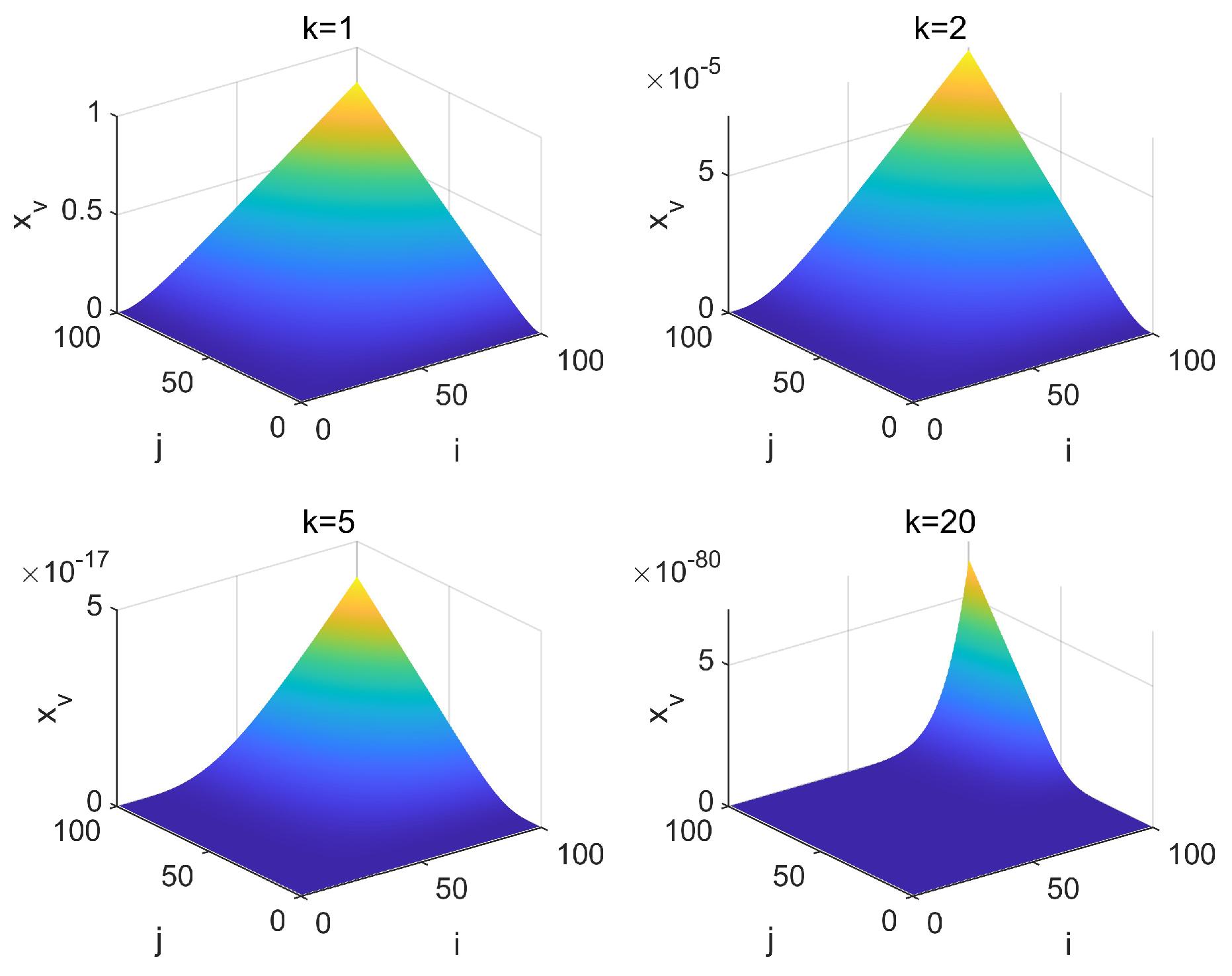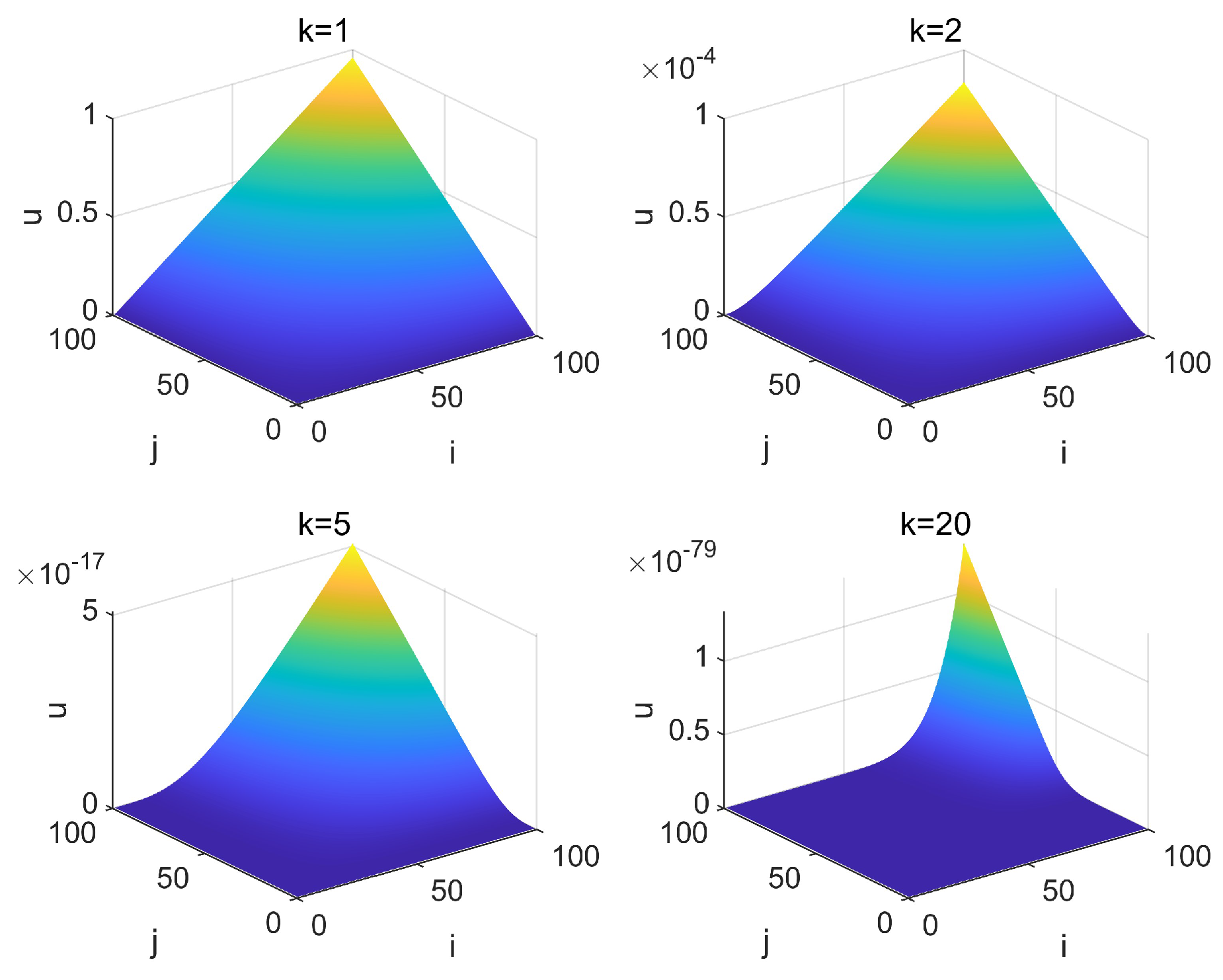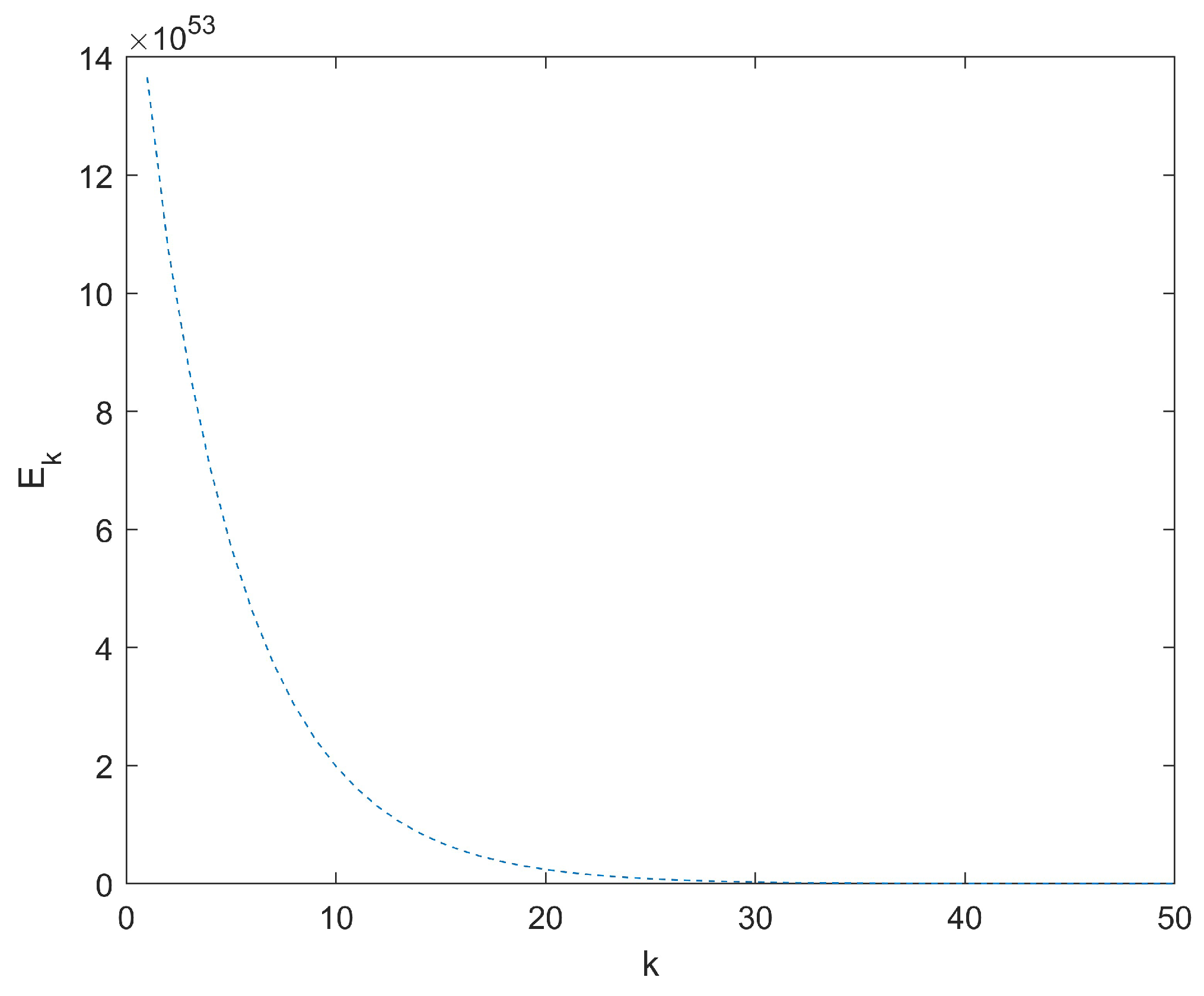Iterative Dissipativity of Partial Difference Equation Dynamics in Open-Loop Iterative Learning Control Mode
Abstract
1. Introduction
2. Iterative Dissipativity of 3-D Systems
3. Iterative Convergence Analysis of 3-D Systems
- 1.
- ;
- 2.
- , .
4. Application Examples
4.1. ILC for Thermal Process
4.2. ILC for Unstable Systems
5. Conclusions
Funding
Data Availability Statement
Conflicts of Interest
References
- Lazebnik, T.; Alexi, A. High Resolution Spatio-Temporal Model for Room-Level Airborne Pandemic Spread. Mathematics 2023, 11, 426. [Google Scholar] [CrossRef]
- Kaczorek, T. Two-dimensional linear systems. In Proceedings of the Advances in Control; Frank, P.M., Ed.; Springer: London, UK, 1999; pp. 283–284. [Google Scholar]
- Ali, I.; Saleem, M.T. Spatiotemporal Dynamics of Reaction–Diffusion System and Its Application to Turing Pattern Formation in a Gray–Scott Model. Mathematics 2023, 11, 1459. [Google Scholar] [CrossRef]
- Xu, K.; Li, H.; Yang, H. Local-properties-embedding-based nonlinear spatiotemporal modeling for lithium-Ion battery thermal process. IEEE Trans. Ind. Electron. 2018, 65, 9767–9776. [Google Scholar] [CrossRef]
- Zhang, L.; Liu, S. Iterative learning control for flexible manipulator using fourier basis function. Int. J. Autom. Comput. 2015, 12, 639–647. [Google Scholar] [CrossRef]
- Roesser, R. A discrete state-space model for linear image processing. IEEE Trans. Autom. Control 1975, 20, 1–10. [Google Scholar] [CrossRef]
- Xiao, T.; Li, H. Eigenspectrum-based iterative learning control for a class of distributed parameter system. IEEE Trans. Autom. Control 2017, 62, 824–836. [Google Scholar] [CrossRef]
- Arimoto, S. Mathematical Theory of Learning with Applications to Robot Control. In Adaptive and Learning Systems: Theory and Applications; Narendra, K.S., Ed.; Springer: Boston, MA, USA, 1986; pp. 379–388. [Google Scholar]
- Wang, Y.; Gao, F.; Doyle, F.J. Survey on iterative learning control, repetitive control, and run-to-run control. J. Process Control 2009, 19, 1589–1600. [Google Scholar] [CrossRef]
- Xu, Q.Y.; He, W.Y.; Zheng, C.T.; Xu, P.; Wei, Y.S.; Wan, K. Adaptive Fuzzy Iterative Learning Control for Systems with Saturated Inputs and Unknown Control Directions. Mathematics 2022, 10, 3462. [Google Scholar] [CrossRef]
- Attia, S.B.; Alzahrani, S.; Alhuwaimel, S.; Salhi, S.; Ouerfelli, H.E. Polynomial Iterative Learning Control (ILC) Tracking Control Design for Uncertain Repetitive Continuous-Time Linear Systems Applied to an Active Suspension of a Car Seat. Mathematics 2024, 12, 2573. [Google Scholar] [CrossRef]
- Wei, Y.; Ouyang, Y.; Shang, W. Higher-order iterative learning control for nonlinear continuous systems with variable input trail lengths and input saturation. Discret. Contin. Dyn. Syst. 2024, 17, 2912–2930. [Google Scholar] [CrossRef]
- Cichy, B.; Gałkowski, K.; Rogers, E.; Kummert, A. An approach to iterative learning control for spatio-temporal dynamics using nD discrete linear systems models. Multidimens. Syst. Signal Process. 2011, 22, 83–96. [Google Scholar] [CrossRef][Green Version]
- Cichy, B.; Gałkowski, K.; Rogers, E. Iterative learning control for spatio-temporal dynamics using Crank-Nicholson discretization. Multidimens. Syst. Signal Process. 2012, 23, 185–208. [Google Scholar] [CrossRef][Green Version]
- Dai, X.; Tian, S.; Guo, Y. Iterative learning control for discrete parabolic distributed parameter systems. Int. J. Autom. Comput. 2015, 12, 316–322. [Google Scholar] [CrossRef][Green Version]
- Xiao, T.; Li, X.D. PID-type Iterative Learning Control for 2-D Roesser Model. In Proceedings of the 2017 6th Data Driven Control and Learning Systems, Chongqing, China, 26–27 May 2017; pp. 400–404. [Google Scholar]
- Wan, K.; Li, X. Iterative learning control for two-dimensional linear discrete systems with Fornasini-Marchesini model. Int. J. Control Autom. Syst. 2017, 15, 1710–1719. [Google Scholar] [CrossRef]
- Willems, J.C. Dissipative dynamical systems part I: General theory. Arch. Ration. Mech. Anal. 1972, 45, 321–351. [Google Scholar] [CrossRef]
- Willems, J.C. Dissipative dynamical systems Part II: Linear systems with quadratic supply rates. Arch. Ration. Mech. Anal. 1972, 45, 352–393. [Google Scholar] [CrossRef]
- Hill, D.J.; Moylan, P.J. Stability results for nonlinear feedback systems. Automatica 1977, 13, 377–382. [Google Scholar] [CrossRef]
- Tan, Z.Q.; Soh, Y.C.; Xie, L.H. Dissipative control for linear discrete-time systems. Automatica 1999, 35, 1557–1564. [Google Scholar] [CrossRef]
- Ahn, C.K.; Shi, P.; Basin, M.V. Two-dimensional dissipative control and filtering for roesser model. IEEE Trans. Autom. Control 2015, 60, 1745–1759. [Google Scholar] [CrossRef]
- Pakshin, P.; Emelianova, J.; Emelianov, M.; Galkowski, K.; Rogers, E. Passivity based stabilization of repetitive processes and iterative learning control design. Syst. Control Lett. 2018, 122, 101–108. [Google Scholar] [CrossRef]
- Emelianova, J.; Pakshin, P.; Galkowski, K.; Rogers, E. Dissipative stabilization of nonlinear repetitive processes with an iterative learning control application. In Proceedings of the 2019 American Control Conference (ACC), Philadelphia, PA, USA, 10–12 July 2019; pp. 2861–2866. [Google Scholar]
- Ghanbari, V.; Duenas, V.H.; Antsaklis, P.J.; Dixon, W.E. Passivity-based iterative learning control for cycling induced by functional electrical stimulation with electric motor assistance. IEEE Trans. Control Syst. Technol. 2019, 27, 2287–2294. [Google Scholar] [CrossRef]
- Ahn, H.; Chen, Y.; Moore, K.L. Iterative Learning Control: Brief Survey and Categorization. IEEE Trans. Syst. Man Cybern. Part C Appl. Rev. 2007, 37, 1099–1121. [Google Scholar] [CrossRef]
- Cichy, B.; Augusta, P.; Gałkowski, K.; Rauh, A.; Aschemann, H.; Rogers, E.; Rehák, B. Modeling and Iterative Learning Control of a Circular Deformable Mirror. IFAC-PapersOnLine 2017, 50, 3117–3122. [Google Scholar] [CrossRef]
- Boyd, S.; El Ghaoui, L.; Feron, E.; Balakrishnan, V. Linear Matrix Inequalities in System and Control Theory; Studies in Applied and Numerical Mathematics; Society for Industrial and Applied Mathematics: Philadelphia, PA, USA, 1994; p. 194. [Google Scholar]
- Gahinet, P.; Nemirovskii, A.; Laub, A.J.; Chilali, M. The LMI control toolbox. In Proceedings of the 1994 33rd IEEE Conference on Decision and Control, Lake Buena Vista, FL, USA, 14–16 December 1994; pp. 2038–2041. [Google Scholar]
- Du, C.; Xie, L. H∞ Control and Filtering of Two-Dimensional Systems; Lecture Notes in Control and Information Sciences; Springer: Berlin/Heidelberg, Germany, 2002; p. 152. [Google Scholar]
- El-Agizi, N.; Fahmy, M. Two-dimensional digital filters with no overflow oscillations. IEEE Trans. Acoust. Speech Signal Process. 1979, 27, 465–469. [Google Scholar] [CrossRef]






Disclaimer/Publisher’s Note: The statements, opinions and data contained in all publications are solely those of the individual author(s) and contributor(s) and not of MDPI and/or the editor(s). MDPI and/or the editor(s) disclaim responsibility for any injury to people or property resulting from any ideas, methods, instructions or products referred to in the content. |
© 2024 by the author. Licensee MDPI, Basel, Switzerland. This article is an open access article distributed under the terms and conditions of the Creative Commons Attribution (CC BY) license (https://creativecommons.org/licenses/by/4.0/).
Share and Cite
Xiao, T. Iterative Dissipativity of Partial Difference Equation Dynamics in Open-Loop Iterative Learning Control Mode. Mathematics 2024, 12, 3128. https://doi.org/10.3390/math12193128
Xiao T. Iterative Dissipativity of Partial Difference Equation Dynamics in Open-Loop Iterative Learning Control Mode. Mathematics. 2024; 12(19):3128. https://doi.org/10.3390/math12193128
Chicago/Turabian StyleXiao, Tengfei. 2024. "Iterative Dissipativity of Partial Difference Equation Dynamics in Open-Loop Iterative Learning Control Mode" Mathematics 12, no. 19: 3128. https://doi.org/10.3390/math12193128
APA StyleXiao, T. (2024). Iterative Dissipativity of Partial Difference Equation Dynamics in Open-Loop Iterative Learning Control Mode. Mathematics, 12(19), 3128. https://doi.org/10.3390/math12193128




